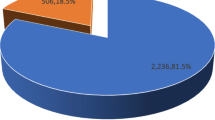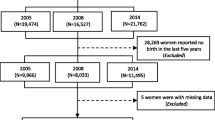Abstract
With increasing institutional deliveries, India has witnessed an increasing prevalence of caesarean births since 2005–2006, which by 2019–2021 increased a manifold more than WHO’s estimated acceptable proportion. The paper envisages addressing the critical research question of whether private health facilities and providers are fuelling caesarean births, which could have otherwise been avoided in the overall institutional deliveries in India? Data used are from the two rounds of Indian DHS, known as NFHS. Findings are from NFHS-5 (2019–2021) with the corresponding values from NFHS-4 (2015–2016). Descriptive statistics, bivariate, and multivariate regression analysis have been used to portray caesarean births' significant cofactors across 36 states/UTs at state, 707 districts. Twenty-two percent of live births in India in the five years preceding NFHS-5 (2019–2021) were caesarean births, up from 17 percent in 2015–2016 and 9 percent in 2005–2006. Caesarean deliveries among the births in private health facilities were as high as 47 percent. The predicted probabilities of caesarean births substantially increased over the last five years, especially among young mothers, those having lower order births, well educated, and delivering in private health facilities. Disproportionately higher caesarean births in private health facilities, especially among young mothers having lower order births, exist in different states/districts despite the recent opposition to such a high prevalence of caesarean births. As a substantial proportion of caesarean births are provider-driven avoidable operations, where higher financial gains may be the real motive, it should be minimized.



Similar content being viewed by others
Data availability
The data used in this study are available in the public domain of NFHS website http://rchiips.org/nfhs/factsheet_NFHS-5.shtml.
Abbreviations
- NFHS:
-
National Family Health Survey
- IIPS:
-
International Institute for Population Sciences
- MoHFW:
-
Ministry of Health and Family Welfare
References
Aditi A, Jaiswal AK, Qamar A (2022) Gap in breast feeding practices between caesarean and normal deliveries. Int J Pregn Child Birth 8(3):48–53. https://doi.org/10.15406/ipcb.2022.08.00260
Ajeet S, Nandkishore K (2013) The boom in unnecessary cesarean surgeries is jeopardizing women’s health. Health Care Women Int 34(6):513–521. https://doi.org/10.1080/07399332.2012.721416
Ajeet S, Jaydeep N, Nandkishore K, Nisha R (2011) Women’s knowledge, perceptions, and potential demand towards the cesarean section. Natl J Commun Med 2(2):244–248
Amorim MM, Souza ASR, Katz L (2017) Planned caesarean section versus planned vaginal birth for severe pre-eclampsia. Cochrane Database Syst Rev 10(10):CD009430. https://doi.org/10.1002/14651858.CD009430.pub2
Bayou YT, Mashalla YJ, Thupayagale-Tshweneagae G (2016) Patterns of caesarean-section delivery in Addis Ababa, Ethiopia. Afr J Prim Health Care Fam Med 8(2):e1-6. https://doi.org/10.4102/phcfm.v8i2.953
Bell JS, Campbell DM, Graham WJ, Penney GC, Ryan M, Hall MH (2011) Do obstetric complications explain high caesarean section rates among women over 30? A retrospective analysis. BMJ 322(7291):894–895. https://doi.org/10.1136/bmj.322.7291.894
Bertollini R, DiLallo D, Spadea T, Perucci C (1992) Cesarean section rates in Italy by hospital payment mode: an analysis based on birth certificates. Am J Public Health 82(2):257–261. https://doi.org/10.2105/ajph.82.2.257
Betrán AP, Merialdi M, Lauer JA, Bing-Shun W, Thomas J, Van Look P, Wagner M (2007) Rates of caesarean section: analysis of global, regional and national estimates. Paediatr Perinat Epidemiol 21(2):98–113. https://doi.org/10.1111/j.1365-3016.2007.00786.x
Betrán AP, Ye J, Moller A et al (2021) Trends and projections of caesarean section rates: global and regional estimates. BMJ Glob Health 6:e005671
Bhasin SK, Rajoura OP, Sharma AK, Metha M, Gupta N, Kumar S, Joshi ID (2007) A high prevalence of caesarean section rate in East Delhi. Indian J Commun Med 32(3):222
Bhatia M, Banerjee K, Dixit P, Dwivedi LK (2020) Assessment of variation in Cesarean delivery rates between public and private health facilities in India from 2005 to 2016. JAMA Netw Open 3(8):e2015022. https://doi.org/10.1001/jamanetworkopen.2020.15022
Cavallaro FL, Cresswell JA, França GV, Victora CG, Barros AJ, Ronsmans C (2013) Trends in caesarean delivery by country and wealth quintile: cross-sectional surveys in southern Asia and sub-Saharan Africa. Bull World Health Organ 9(91):914–922
Hall MH (1994) Variation in caesarean section rate. Maternal mortality higher after caesarean section. BMJ 308(6929):654–655
IIPS and ICF (2017) National Family Health Survey (NFHS-4), 2015-16. Mumbai, India
IIPS and ICF (2021) National Family Health Survey (NFHS-5), 2019-20. Mumbai, India
Kamal SM (2013) Preference for institutional delivery and caesarean sections in Bangladesh. J Health Popul Nutr 31(1):96–109. https://doi.org/10.3329/jhpn.v31i1.14754
Kaur J, Singh S, Kaur K (2013) Current trend of caesarean sections and vaginal births. Adv Appl Sci Res 4(4):196–202
Khan MN, Islam MM, Shariff AA, Alam MM, Rahman MM (2017) Socio-demographic predictors and average annual rates of caesarean section in Bangladesh between 2004 and 2014. PLoS ONE 12(5):e0177579
Kiran TU, Jayawickrama NS (2002) Who is responsible for the rising caesarean section rate? J Obstet Gynaecol 22(4):363–365. https://doi.org/10.1080/01443610220141263
Kumbhar K (2020) The cesarean rate is still rising, and shaming doctors won’t solve it. 2017. https://theswaddle.com/india-c-section-rates-rising-shaming-doctors-not-working/. Accessed 25 June 2020
Leone T, Padmadas SS, Matthews Z (2008) Community factors affecting rising caesarean section rates in developing countries: an analysis of six countries. Soc Sci Med 67(8):1236–1246. https://doi.org/10.1016/j.socscimed.2008.06.032
Maktha VK, Ghatam A, Padamata H, Ravulakol A (2016) Prevalence and factors associated with caesarean section: a community based cross sectional study in rural parts of Rangareddy district, Telangana, India. Int J Community Med Public Health 3(8):2054–2057
Mazzoni A, Althabe F, Liu NH, Bonotti AM, Gibbons L, Sánchez AJ, Belizán JM (2011) Women’s preference for caesarean section: a systematic review and meta-analysis of observational studies. BJOG 118(4):391–399. https://doi.org/10.1111/j.1471-0528.2010.02793.x
Meitei WB, Aditi (2021) Menstrual hygiene: an important prognosticator of excessive vaginal bleeding in the high focused states of India. Int J Pregn Child Birth 7(6):161–165
Mishra US, Ramanathan M (2002) Delivery-related complications and determinants of caesarean section rates in India. Health Policy Plan 17(1):90–98. https://doi.org/10.1093/heapol/17.1.90
Montagu D, Yamey G, Visconti A, Harding A, Yoong J (2011) Where do poor women in developing countries give birth? A multi-country analysis of demographic and health survey data. PLoS ONE 6(2):e17155
Naa Gandau BB, Nuertey BD, Seneadza NA, Akaateba D, Azusong E, Yirifere JY, Kankpeyeng HB, Tette E (2019) Maternal perceptions about caesarean section deliveries and their role in reducing perinatal and neonatal mortality in the Upper West Region of Ghana; a cross-sectional study. BMC Pregnancy Childbirth 19(1):1–4
Nerum H, Halvorsen L, Sørlie T, Øian P (2006) Maternal request for cesarean section due to fear of birth: can it be changed through crisis-oriented counseling? Birth 33(3):221–228
Neu J, Rushing J (2011) Cesarean versus vaginal delivery: long-term infant outcomes and the hygiene hypothesis. Clin Perinatol 38(2):321–331
Neuman M, Alcock G, Azad K, Kuddus A, Osrin D, More NS, Nair N, Tripathy P, Sikorski C, Saville N, Sen A, Colbourn T, Houweling TA, Seward N, Manandhar DS, Shrestha BP, Costello A, Prost A (2014) Prevalence and determinants of caesarean section in private and public health facilities in underserved South Asian communities: cross-sectional analysis of data from Bangladesh, India and Nepal. BMJ Open 4(12):e005982. https://doi.org/10.1136/bmjopen-2014-005982
Padmadas SS, Kumar S, Nair SB, Kumari A (2000) Caesarean section delivery in Kerala, India: evidence from a national family health survey. Soc Sci Med 51(4):511–521. https://doi.org/10.1016/s0277-9536(99)00491-8
Panda BK, Nayak I, Mishra US (2020) Determinant of inequality in cesarean delivery in India: a decomposition analysis. Health Care Women Int 41(7):817–832
Patel RV, Gosalia EV, Deliwala KJ, Vasa PB, Pandya VM (2014) Indications and trends of caesarean birth delivery in the current practice scenario. Int J Reprod Contracept Obstet Gynecol 3(3):575–580
Roy A, Paul P, Chouhan P, Rahaman M, Kapasia N (2021) Geographical variability and factors associated with caesarean section delivery in India: a comparative assessment of Bihar and Tamil Nadu. BMC Public Health 21(1):1–5
Ryding EL (1993) Investigation of 33 women who demanded a cesarean section for personal reasons. Acta Obstet Gynecol Scand 72(4):280–285. https://doi.org/10.3109/00016349309068038
Savage W (2007) The rising caesarean section rate: a loss of obstetric skill? J Obstet Gynaecol 27(4):339–346. https://doi.org/10.1080/01443610701337916
Sengupta A, Sagayam MS, Reja T (2021) Increasing trend of C-section deliveries in India: a comparative analysis between southern states and rest of India. Sexual & Reproductive Healthcare 1(28):100608
Shabnam J, Gifford M, Dalal K (2011) Socioeconomic inequalities in the use of delivery care services in Bangladesh: a comparative study between 2004 and 2007. Health 2011:762–771. https://doi.org/10.4236/health.2011.312127
Singh P, Hashmi G, Swain PK (2018) High prevalence of caesarean section births in private sector health facilities-analysis of district level household survey-4 (DLHS-4) of India. BMC Public Health 18(1):613. https://doi.org/10.1186/s12889-018-5533-3
Singh SK, Vishwakarma D, Sharma SK (2020) Prevalence and determinants of voluntary caesarean deliveries and socioeconomic inequalities in India: evidence from National Family Health Survey (2015–16). Clin Epidemiol Glob Health 8(2):335–342
Sreevidya S, Sathiyasekaran BW (2003) High caesarean rates in Madras (India): a population-based cross-sectional study. BJOG 110(2):106–111
Størksen HT, Garthus-Niegel S, Adams SS, Vangen S, Gran ME (2015) Fear of childbirth and elective caesarean section: a population-based study. BMC Pregnancy Childbirth. https://doi.org/10.1186/s12884-015-0655-4
Suwanrath C, Chunuan S, Matemanosak P, Pinjaroen S (2021) Why do pregnant women prefer cesarean birth? A qualitative study in a tertiary care center in Southern Thailand. BMC Pregnancy Childbirth 21(1):1–6
Vieira GO, Fernandes LG, de Oliveira NF, Silva LR, Vieira TDO (2015) Factors associated with cesarean delivery in public and private hospitals in a city of northeastern Brazil: a cross-sectional study. BMC Pregnancy Childbirth 15(1):1–9
Weimer KR, Farmer CJ, Reid CE (2019) A Spatial View of how United States cesarean section rates changed from 1990 to 2014. Prof Geogr 71(4):762–769
WHO (2015) WHO statement on caesarean section rates? https://www.who.int/reproductivehealth/publications/maternal_perinatal_health/cs-statement/en/
Acknowledgements
The authors of the paper acknowledge the NFHS team at IIPS for releasing the district and state-level fact sheet to conduct this research.
Funding
This research did not receive a specific grant from any funding agency, commercial entity, or nor-for-profit organization.
Author information
Authors and Affiliations
Contributions
S.K.S.: conceptualization, methodology, investigation, writing, reviewing, and editing. A.: interpretation, writing, reviewing, and editing; S.K.S.: data preparation, methodology, formal analysis, reviewing, and editing.
Corresponding author
Ethics declarations
Conflict of interest
The authors declare that they have no competing interests.
Ethical approval
Since the study has used secondary data which are available in public domain, no consent to participate was needed.
Consent for publication
Not applicable.
Rights and permissions
About this article
Cite this article
Singh, S.K., Aditi & Sharma, S.K. Changing the Discourse on Caesarean Births in India: Issues emerging from NFHS-5 (2019–2021). SN Soc Sci 2, 103 (2022). https://doi.org/10.1007/s43545-022-00406-8
Received:
Accepted:
Published:
DOI: https://doi.org/10.1007/s43545-022-00406-8




